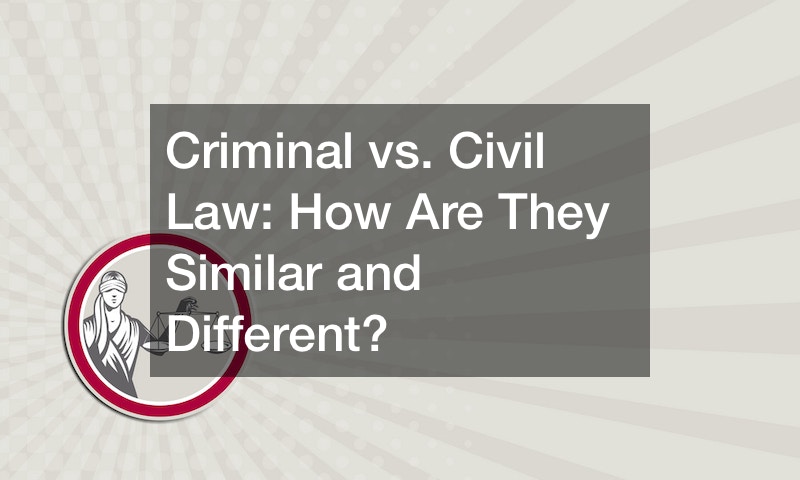
Understanding the nuances between criminal and civil law is crucial in the intricate world of law. While distinct in their nature and consequences, these two branches also share common ground. This article aims to unravel how criminal and civil law are similar and different, providing a clear picture for those navigating legal issues. Criminal law, dealing with offenses against the state, involves stringent procedures and the involvement of defense attorneys to uphold justice.
In contrast, civil law encompasses personal disputes between individuals or organizations, often requiring the expertise of estate planning attorneys or bankruptcy lawyers. As we delve deeper, we will explore the fundamental differences, similarities, and unique scenarios where these two realms intertwine. Understanding these facets is essential in recognizing the multifaceted nature of law, where similar and different elements coexist and shape the legal landscape.
Understanding Criminal Law

Criminal law, a fundamental pillar of the legal system, addresses behaviors and actions deemed offenses against society or the state. It encompasses a range of activities, from minor misdemeanors to serious felonies, each carrying distinct legal ramifications. At the heart of this system are defense attorneys, whose role is to represent and defend the accused, ensuring a fair trial and upholding justice.
In criminal law, the state, represented by a prosecutor, charges an individual or organization with a crime. The severity of the charge, whether it’s a minor theft or a major fraud, dictates the course of legal proceedings. The main goal of criminal law is to maintain public order and safety, and consequences often include imprisonment, fines, or community service. The process is designed to be rigorous and thorough, with evidence and legal standards like ‘beyond a reasonable doubt’ playing a pivotal role.
Defense attorneys in criminal law are crucial. They navigate the complexities of legal statutes, advocate for the accused’s rights, and strive to ensure a just outcome. Whether negotiating plea deals or representing clients in court, their expertise and understanding of criminal law are vital in balancing the scales of justice.
Criminal law serves a dual purpose: it’s not only about penalizing wrongdoing but also about safeguarding the rights and liberties of the accused. This branch of law, reflective of societal ethics and standards, is crucial in preserving public order and administering justice. By striking a balance between these objectives, criminal law stands as a cornerstone in the legal framework, upholding fairness and equity in the judicial process.
The Difference Between a Misdemeanor and a Felony
Understanding the distinction between a misdemeanor and a felony is fundamental to how criminal law delineates similar and different levels of legal transgressions. Misdemeanors, considered less severe, often result in lighter sentences like fines or short-term jail time. These offenses may include acts like petty theft or minor traffic violations, highlighting a category of crime that, while serious, is viewed differently from more grave offenses.
Felony charges, in contrast, address significantly different and more serious crimes, such as violent acts or major theft. The consequences of felonies are more severe, typically involving longer prison sentences and greater fines. This stark contrast in handling misdemeanors and felonies showcases the legal system’s approach to categorizing crimes based on their severity and societal impact.
Criminal defense attorneys navigate these similar yet different legal territories, advocating for their client’s rights whether they face misdemeanor or felony charges. The bail bonds process, another critical aspect of the criminal justice system, also reflects these differences. Misdemeanor cases often require lower bail amounts, while felonies, due to their higher severity, entail more substantial bail conditions.
This differentiation between misdemeanors and felonies exemplifies the criminal law’s nuanced approach to categorizing offenses. It highlights how the legal system distinguishes between various levels of criminal behavior, illustrating that similar actions can have vastly different legal interpretations and consequences. Through this framework, criminal law effectively addresses the complexities of justice, ensuring that each crime is met with an appropriate and proportional response.
Understanding Civil Law

Civil law, setting itself apart from criminal law, primarily deals with disputes between individuals or organizations. This branch includes areas like estate planning, where individuals arrange for the management and distribution of their assets. Unlike criminal law, which involves the state prosecuting violations of societal rules, civil law centers on resolving private disputes, often necessitating the expertise of an estate planning attorney.
Estate planning is a common area in civil law where individuals plan the management and distribution of their assets in the event of incapacitation or death. Estate planning attorneys play a vital role in this process, providing guidance on wills, trusts, and other legal instruments to ensure a person’s wishes are fulfilled. This aspect of civil law differs from criminal law, as it deals with personal financial and property matters rather than offenses against the state.
Civil law encompasses various legal issues, from contract disputes to property matters, each requiring a specialized approach. The primary goal in civil law cases is to resolve disputes and provide remedies, such as monetary compensation or specific performance, rather than to punish. This makes civil law a fundamentally different realm of the legal system, focused more on rectifying wrongs and restoring balance between the disputing parties.
Understanding civil law, particularly in contexts like estate planning, is crucial for navigating legal scenarios that highlight how civil and criminal law are similar and different. Estate planning attorneys provide essential expertise in managing personal and property rights, emphasizing the divergent and personalized nature of civil law compared to criminal law. Their role underscores the unique facets of legal issues, where the similarities and differences between the two branches of law become evident in practical application.
What Can Stop a Civil Lawsuit?

In civil law, various factors can halt a lawsuit, and understanding these can be crucial. One significant factor is the intervention of bankruptcy lawyers. A defendant filing for bankruptcy often leads to an automatic stay on most civil lawsuits. This stay is a legal hold that prevents creditors from pursuing debt collection, including civil lawsuits, against the person who has declared bankruptcy.
Bankruptcy can alter the course of a civil lawsuit significantly. It shifts the focus from the lawsuit to the bankruptcy proceedings, where the court assesses the debtor’s assets and liabilities. This process can resolve the underlying issues of the lawsuit in a manner that is similar and yet different from the typical resolution of civil disputes. In bankruptcy, the resolution is more about debt management and asset distribution rather than the direct settlement of the dispute, as in a standard civil lawsuit.
The intervention of bankruptcy lawyers showcases a unique intersection between civil law and bankruptcy law. They navigate through these similar and different legal waters, aiming to protect their client’s interests in the context of both the civil lawsuit and the bankruptcy proceedings. Their role is pivotal in ensuring that their client’s financial and legal challenges are addressed comprehensively.
Understanding the impact of bankruptcy on civil lawsuits is essential in recognizing how legal procedures can be similar and different across various domains. It underscores the intricacies of law, where the intersection of civil and bankruptcy principles can significantly alter the course and resolution of legal disputes. This complexity emphasizes the need for skilled legal guidance to navigate the overlapping and distinct aspects of these legal areas effectively.
The Key Differences Between Criminal and Civil Law
The distinction between criminal and civil law is a fundamental aspect of the legal system, highlighting how these two branches are similar and different. Criminal law deals with offenses against society or the state, enforced by the government and often resulting in penalties like imprisonment or fines. In contrast, civil law resolves disputes between individuals or entities, usually involving compensation or specific performance rather than punitive measures.
Criminal attorneys play a crucial role in the criminal justice system, representing individuals accused of crimes, while civil cases often involve attorneys specializing in specific areas like contracts or personal injury. This difference in legal representation is just one example of how the roles and responsibilities in each branch vary. In criminal law, the focus is on upholding public order and punishing wrongdoers, whereas civil law aims to resolve private disputes and provide remedies to the aggrieved party.
Another key difference lies in the burden of proof. In criminal cases, the prosecution must prove the defendant’s guilt ‘beyond a reasonable doubt,’ a higher standard reflecting the serious consequences of a criminal conviction. In civil cases, the standard is usually ‘preponderance of the evidence,’ which is a lower threshold suitable for the nature of personal disputes.
Understanding these key differences is essential for recognizing how criminal and civil law function similarly and differently within the legal system. While each branch serves a distinct purpose, they both play crucial roles in maintaining societal order and ensuring justice. This duality underscores the complexity and balance of the legal system, where different legal principles coexist to address a diverse array of legal issues.
Can a Civil Matter Turn Criminal?

The intersection of civil and criminal law raises the question of whether a civil matter can turn into a criminal case. This scenario, while not common, is a possibility in certain circumstances. Family lawyers often encounter situations where issues initially seen as civil disputes, such as those involving family law, escalate into criminal matters.
One example is a domestic dispute that begins as a civil case but becomes criminal if it involves acts of violence or threats. In these instances, the nature of the offense shifts from a private dispute to a violation of criminal statutes. Family lawyers, initially handling the civil aspect, may need to coordinate with criminal attorneys if the situation escalates to criminal charges.
The transition from a civil to a criminal case is a prime example of how legal matters can be similar in their origin but different in their progression and resolution. This shift underscores the importance of understanding the nuances of both civil and criminal law, as actions in one domain can have significant implications in the other. It highlights the interconnected nature of the legal system, where seemingly distinct areas can converge under certain circumstances, reflecting the complexity and adaptability of legal proceedings.
Recognizing when a civil matter can turn criminal is crucial, as it highlights the fluid and sometimes overlapping boundaries between civil and criminal law. This situation exemplifies how legal matters can be similar in their origin but different in their progression and resolution, reflecting the dynamic nature of the legal landscape. Understanding these transitions is key for legal professionals and those involved in disputes, as it underscores the importance of nuanced legal knowledge in both civil and criminal domains.
Can a Case Be Both Criminal and Civil?
Cases that straddle criminal and civil law realms often present scenarios where the legal issues are strikingly similar and different. DUI attorneys, for instance, encounter situations where a single incident, such as driving under the influence, triggers both criminal charges and a civil lawsuit. This dual pathway exemplifies how a single act can lead to legal consequences that are both similar and different in nature.
On the criminal side, a DUI case involves the state’s prosecution for violating traffic laws, where the focus is on punishment and deterrence. Simultaneously, the civil aspect of the same incident aims to address personal losses, with victims seeking compensation for damages or injuries. This shows how the legal consequences of one act can be similar in their basis but different in their purpose and resolution.
The interplay of criminal and civil proceedings in such cases underscores the intricate relationship between these two legal branches. It reveals the nuanced ways in which legal matters can be both similar and different, demanding a comprehensive understanding and approach to legal representation. This complexity showcases the adaptability and breadth of the legal system in addressing varied aspects of a single incident.
Final Thoughts
The exploration of criminal and civil law reveals a legal landscape where the elements are profoundly similar and different. While these two branches serve distinct functions, their interplay in certain cases highlights the versatility and complexity of the legal system. Understanding this duality is crucial for anyone navigating legal issues, as it provides insight into how different legal principles apply in varying contexts.
The similarities and differences between criminal and civil law underscore the importance of specialized legal expertise. Whether dealing with defense attorneys in criminal cases or estate planning attorneys in civil matters, the right legal guidance is essential. This understanding enriches our comprehension of the law, demonstrating its capacity to adapt and address a diverse range of scenarios, each with its unique challenges and implications.




